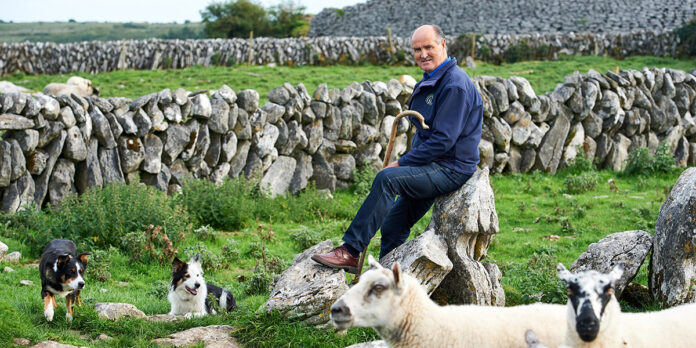The dedication of generations of Davorens to preserving the ancient heritage of North Clare will be recognised later this month as John Davoren of Caherconnell Stone Fort will be awarded an honorary doctorate by the University of Galway.
The lineage of the O’Davoren Clan in the Burren can be traced back to around 600AD, and John Davoren’s ancestors have been farming on the land around Caherconnell Stone Fort for at least 300 years.
Their commitment to the ancient heritage of the area began long before they developed the fort as a tourist attraction and an archaeological field school. Indeed, generations of Davorens have felt a responsibility for the fort and a commitment to maintain it as a living record of the past.
“We are on this land for 300 years at least. When the genealogy centre was first opened in Corofin, the first family that they looked into was the O’Davorens. We have been in this area from around 600AD, but we weren’t on this particular farm until somewhere in the 1700s,” said John.
“We have always considered the fort as something that was worth preserving. That was handed down to us for generations. If a stone fell off the fort, my father wouldn’t allow me to put it up on a wall beside the fort, it had to go back on the fort again in the place where it came from.
“We spent a lot of years developing the farm but always, in the back of our minds, was doing something with the fort.
“We always saw ourselves as the custodians of the fort. As a custodian, what you give is far more than what you receive, so we were hoping to leave something behind us. So we decided that we would have a go at the stone fort as a tourist attraction.”
John Davoren is one of five people who will be awarded an honorary doctorate by the University of Galway later this month. He has always had an interest in education, but only reached Inter Cert level himself, and admits that the call from the University of Galway was a big surprise.
“I was amazed really. Sure, I never thought anything like that would happen to me. It was way outside of my league,” he said.
“I was standing in the calf shed when the phone rang telling me what was happening. God almighty, if it was April Fools Day I wouldn’t have believed it. But I’m delighted with it.
“I’ve always had a great value on education. My children have reaped the rewards of education over the years but I never went further than the Inter Cert at St Mary’s College. I probably played more sports than I studied at school, but I got the Inter Cert and after that I went farming with my Dad. To get an honorary doctorate for me is something amazing.”
John gives much of the credit for developing Caherconnell Stone Fort to Dr Michelle Comber of the University of Galway. A series of excavations at and around the fort have reshaped our understanding of ancient Irish people.
“It is all about the people you meet along the way and the connections you make,” he said.
“We were so fortunate to meet Dr Michelle Comber and make the connection with the University of Galway, that’s what really launched us.
“Dr Comber is our field school director and she oversaw all of the excavations all down through the years. As the excavations went on down through the years, it has taken the history of the fort on to a whole different level.
“When the history of the western forts was taught, they were thought to be uninhabited by the 12th century.
“But the excavations here in Caherconnell have shown that they were inhabited for a couple of centuries after that.
“It isn’t that they didn’t interact with the outside world, they did, and they had the wherewithal to copy them if they wished. But they decided that they would continue to live in their stone forts. That was proven here in Caherconnell.
“The Caherconnell project has changed the way that archaeology is taught in Ireland and oversees as well.”
As well as the groundbreaking work on the fort itself, hundreds of students have gained invaluable experience working at the field school in Carron over the years.
“We get a lot of students from America, some from Canada and some from Australia down through the years. We have hundreds of students through here over the years who have gained valuable experience,” said John.
“Every new artifact that comes up out of the ground is special, of course it is. Dr Comber, who is assisted by Dr Noel McCarthy are responsible for the excavation every year.
“I’d be doing the sheep-dogs and I’d go down to them after and they’d tell me what they have found for the day.
“They’d explain it all to me. The enthusiasm that they have about it, it would put the heart across you, whether you understood it or not. Their enthusiasm always lifts you up.
“I remember one day, early in the excavation, they had just cleared a pathway that was running into the fort. I remember one of the students jumped onto the path when it was cleared. She said, ‘look, I’m the first person to walk on this path for a thousand years and I’m the only American ever to walk on it’. The excitement is amazing, it’s something else.
“When the students come up for dinner, that’s the first thing that they talk about, what they found that day. It is hard work for them.
“They have to do a lot of digging before they start to find anything. They work hard for every find they make.
“But when they find something, the excitement is amazing. There is no one talking about the aches and pains in their legs and backs on those days.
John Davoren will be awarded an honorary doctorate in Science from the University of Galway on August 26.
This is in recognition of his pioneering work establishing a highly successful archaeological school in collaboration with the University of Galway.
As well as the field school, Caherconnell Stone Fort also hosts archaeologist led guided tours of the fort and interactive sheepdog shows throughout the summer months.
Andrew Hamilton is a journalist, investigative reporter and podcaster who has been working in the media in Ireland for the past 20 years. His areas of special interest include the environment, mental health and politics.


